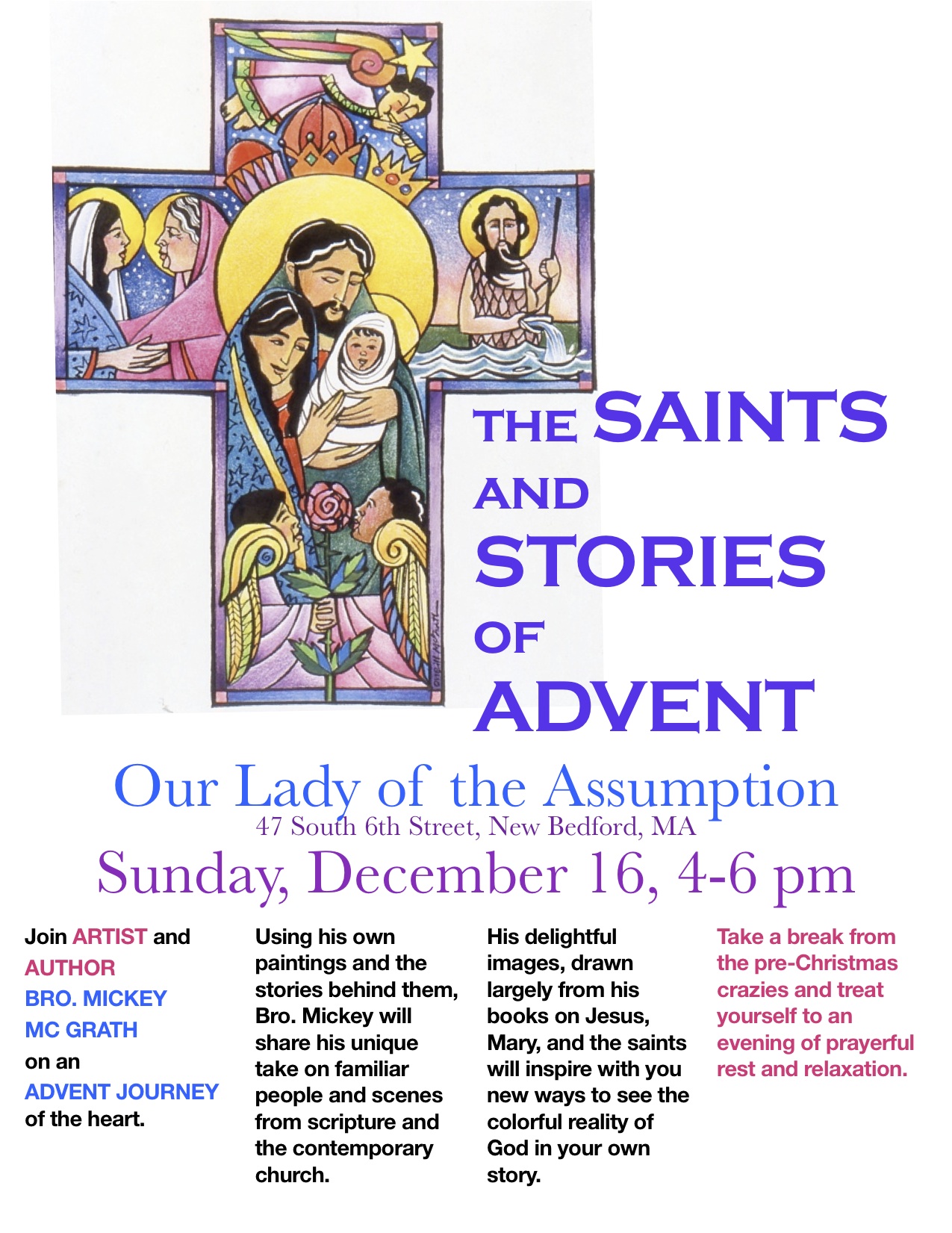AGGIORNAMENTO: An Italian word meaning "a spirit of renewal." The word was first used by Saint Pope John XXIII at the beginning of the Second Vatican Council.
A new year’s resolution the Church cannot afford to dismiss
Happy New Year, Church!
One year into the third edition of the new Roman Missal, the editorials, blogs, news and reports from pastoral and diocesan leaders continue to comment on the missal’s effect on worshipping Catholic communities.
I’m a big believer of what Vatican II refers to as the sensus fidelium, which teaches that “the universal body of the faithful, who have received the anointing of the holy one, cannot be mistaken in belief.” (Lumen Gentium, 12) This statement affirms the share of the baptized as the holy people of God who share in the prophetic role of Christ. (LG 12)
The sensus fidelium invites a mutuality of dialogue between the teaching magisterium of the Church and the people of God, offering an opportunity for each to share in the process of dialogue, discernment and dynamic equivalence that provides the opportunity for a more inclusive and reconciling dimension of ecclesial life, which creates a stronger bridge to full, conscious and active participation of the people at the table of word and feast. (SC 14)
That said, I became very interested in a recent poll conducted by CARA at Georgetown University that released research that found that 70 percent of Catholics agreed that the new translation of the prayers in the new Roman Missal is a good thing. (To read CNA’s complete article, click http://www.catholicnewsagency.com/news/catholics-strongly-support-new-mass-translation-after-first-year/
While I applaud the attention given to the sensus fidelium regarding the new prayers of the Roman Missal as we turn the corner in the one year anniversary at the beginning of a new year in Advent, I have some questions about the poll.
Which communities were polled by CARA?
Was there a national invitation extended to each diocese and to each parish to offer their comments on people’s experience of the 3rd edition of the Roman Missal?
Were Catholic schools, which celebrate the Mass on a regular basis, invited into the poll? According to the statistics in the CARA report, age difference may impact the reactions of the focus groups to the Missal changes. “The millennial generation, born in 1982 or later, shows the highest rate of dissatisfaction with the new translation, although even among this group, nearly 60 percent approve of the changes.” (CNA article) The suggested reason tied to “findings in other studies that this younger generation is less affiliated with religion and churches in general.” Regardless, is anyone concerned about the 40 percent of persons surveyed who are dissatisfied?
Which members of the millennial generation interviewed for the poll? Which part of the country was interviewed? Was there truly a statistically significant representation of the U.S. Catholic population? What and how many institutions participated in the poll? Parishes? Schools? Youth groups?
Additionally, the polls find that people born before 1943 “may find the new liturgy challenging, struggling to remember the new responses due to their age.” Has the translation actually reduced the opportunity for prayer by senior citizens? Is this acceptable?
Where were the surveys done, in what regions, what institutions (i.e. parish, Catholic nursing homes) and how many elders participated in the poll interview?
A proposal: the Sensus Fidelium and the new Roman Missal
I propose focus groups for all diocesan councils and leaders of offices of worship.
In each diocese, every parish and every Catholic institution (schools, nursing homes, centers of prayer and worship, etc.) have a duty to conduct a survey of the language, the prayerfulness and the level of their engagement in full, conscious and active participation since the change of the new Missal.
How might the hierarchy of the Church take the statistics of the accrued polls and go back to the drawing board if the result does not approach 100% satisfaction? Yes, 100% satisfaction, the correct goal of any new systematic endeavor. Would we be satisfied with less of any quality survey from a health system, an educational system, a government?
How might an expanded and robust survey that embraces ALL opinions, gives them weight and value and accepts that each contribution adds to the holiness of the people of God in worship? Opinions provide a front-line foundation for action that could be taken to improve acceptance of the Missal for those find a lack of prayerfulness of the Missal.
The CNA article clearly notes that this poll is not an end result, but the beginning of an exploration of opinions. Perhaps the sensus fidelium in its fullest ‘sense’ may be a new year’s resolution the Church cannot afford to dismiss.
Advent blessings.
Solemnity of Christ the King in a NYC parish
This past Sunday, I celebrated the Solemnity of Christ the King with my husband at the Church of St. Ignatius Loyola at 980 Park Avenue at 84th Street, New York, NY. You can visit the website at www.saintignatiusloyola.org. Take a bit of time to explore the website of this magnificent church founded and administered by the Society of Jesus (Jesuits). The site includes the church’s history, its myriad ministries and many beautiful photographs of the splendid church, including the famous Mander organ. K. Scott Warren, Director of Music Ministries at St. Ignatius Loyola performed Allegro in F Major by W.A. Mozart as a postlude. Magnificent.
A well trained tongue
A friend who preaches once told me that a good homily requires a minimum of ten hours a week to prepare a worthy homily. My friend is a gifted homilist who takes his ministry seriously. I met one of his counterparts in Fr. George Ritt, S.J., the pastor whose homily exceeded my expectations. Fr. Ritt’s compelling homily propelled us from our pews of praise into post-worship Christian mission as witnesses of the foot washing servant we proclaim as Christ the King. The profound silence in the church served as an indicator of the ‘mystery of Christ ever made present and active in us’ (SC 35.2) within a finely honed homily preached ‘with the greatest care.’ (SC, 35:2) Not general or abstract in his preaching, Fr. Ritt offered concrete examples from the experiences of people in the parish, applying the Gospel to everyday life in very real and riveting paradigms. I marveled at the power of the Word yoked with a “well-trained tongue, that I might know how to speak to the weary a word that will rouse them.” Isaiah 50: 4.
Sacred music
For the last 50 years as a result of the Second Vatican Council, pastoral musicians acted on the principle that the musical liturgy includes the “active participation of the people. “ (SC 113) “Indeed, God, the giver of song, is present whenever his people sing his praises.” (Sing to the Lord: Music in Divine Worship, 1) “The full and active participation by all the people is the aim to be considered before all else, for it is the primary and indispensable source from which the faithful are to derive the true Christian spirit.” (SC, no 14)
As a pastoral musician, I’ve spent the last 50 years practicing and teaching from this directive and inspired principle. Further, with the recent emergence of the third edition of the Roman Missal, ecclesial ministers, ordained and lay worked diligently to compose, teach and rehearse assemblies, choirs and instrumental ensembles the plethora of musical acclamations to maximize participatory outcomes for assemblies worldwide. We continue to do our work on behalf of the church to insure that the participation of the people of God expresses and fortifies faith through the sung liturgy.
On Sunday morning, two combined choirs, a cantor, a string ensemble, a continuo organ near the choirs and the famous Mander pipe organ in the loft worked long and diligently to produce sacred music for the Solemnity of Christ the King. The music was exquisite and I enjoyed every note. However, I found myself struggling a bit with the exclusion of the assembly’s song in the Kyrie, Gloria and particularly the Sanctus as the solo choir and orchestra performed Haydn’s MIssa Brevis. The assembly listened. After 50 years of working toward the full, conscious and active participation of assemblies, I must admit that I felt a like a voice crying out in the wilderness: “What about us?” Listening to Haydn’s Sanctus, “the great cosmic acclamation of praise” (STL 180), which ‘should be sung, especially on Sundays and solemnities” (GIRM, no. 40) felt a bit peculiar. While I have no absolutely no objection to Latin chants and encourage their use as part of Catholic musical heritage (read STL 72-80), I admit that listening as a spectator rather than a participant to a Haydn Sanctus within a Eucharistic celebration really rattled my cage.
The same unexpected paradigm occurred again during Communion. The cantor chanted a Psalm 28 antiphon (Sedebit Dominus Rex – The Lord will sit on his royal throne for ever; the Lord will bless his people in peace), followed by a sung solo of the Benedictus from Missa Brevis, followed by the organ Motet from the same Missa. The assembly processed to the Eucharistic banquet in silence. After so many years of liturgical catechesis on STL # 189 – 194 to foster the “unity of voices,” as well encouraging the posture of standing and singing in solidarity while others feast at the banquet table, I really missed the ‘communicants’ union in spirit by means of the unity of their voices to highlight more clearly the ‘communitarian’ nature of the procession to receive Communion.” (STL 189)
A resounding witness of prayer
I did taste and see a parish that prays, sings and responds in a resounding and full bodied witness in liturgical worship. Their deep appreciation and love of the faith and the liturgy prompted my own gratitude for the rich Catholic tradition that we share and I joined my voice to theirs when the opportunities came. The responsorial psalm, Memorial Acclamation, Great Amen, a chanted Lord’s Prayer, Agnus Dei and hymns were sung with robust enthusiasm. I would guess that the liturgical staff selected seldom used options in liturgical, pastoral and musical decisions for the Solemnity of Christ the King. I must admit that my out of the box musical worship experience sent me back to read the liturgical documents and discern the fine print and the suggested ‘norms’ for sung liturgical worship. The exercise reminded me that prudence, compassion and above all, the full, active and conscious prayer and participation of the people remain the goals that anyone involved in the liturgical arts needs to keep in the forefront of pastoral planning. Thanks be to God for the Second Vatican Council and all that the church has fostered within 50 years of work to that end.
Heartfelt thanks to the Church of St. Ignatius Loyola for their love and labor in the vineyard of the Lord.
Comments on a Commentary about Pastoral Music
On November 16, 2012, National Catholic News published an article entitled “Organists plentiful but not many parishes ‘blessed’ with budget for one” by Beth Griffin. http://catholicphilly.com/2012/11/us-world-news/national-catholic-news/organists-plentiful-but-not-many-parishes-blessed-with-budget-for-one/ Read the article before you proceed.
COMMENTS ON A COMMENTARY ABOUT PASTORAL MUSIC
A WIDE CHURCH
Beth Griffin’s article mentioned a comment by a pastor who referenced the ‘bluegrass’ music of the ‘60’s and ‘70’s. My music ministry began in 1964; I can recall no bluegrass music. I do recall learning the music of Ray Repp, the St. Louis Jesuits, Sebastian Temple, The Damiens, Lucien Deiss, Alexander Peloquin, Joseph Gelineau, Richard Proulx and so many gifted composers who wrote for pennies and gave us wealth beyond gold – sung prayer that disposed open hearts to welcome the Word of God through the language of music. And okay, maybe somewhere in a little mountain church, someone played bluegrass hymns on a banjo. Perhaps someone plays congas or uses guitar, piano, mandolin. We are a wide church. Here’s what Sing to the Lord: Music in Divine Worship tells us about music in worship and cultural diversity:
“The cultural context refers to the setting in which the ritual and spiritual dimensions come into play. Factors such as the age, spiritual heritage, and cultural and ethnic background of a given liturgical assembly must be considered. The choice of individual compositions for congregational participation will often depend on those ways in which a particular group finds it best to join their hearts and minds to the liturgical action.” (STL, 70)
I encourage you to read Ricky Manalo’s excellent survey piece Sing to the Lord: Cultural, Multicultural, and Intercultural Perspectives. http://www.pastoralliturgy.org/resources/1007STL-CulturalPerspectives.php
REALITIES
A local pastor called our home this week and asked if my husband and I could substitute as the pastoral musicians in the absence of the parish’s part-time pastoral musician who works as a full-time nurse on rotating shifts. We know that substitute pastoral musicians can be a bit difficult to find in a pinch and so we try to accommodate the needs of parishes that find themselves in similar situations whenever we can.
“If you don’t come, I’ll have to lead song by myself and people may never come back,” the pastor chuckled. His mirth belied the weight of his message. Presbyteral leadership means everything. This pastor understands very well that the combination of sacred music and words forms a necessary and integral part of a liturgical celebration, an insight gleaned from the Second Vatican Council (Sacrosanctum Concilium, 112). The pastor understands fully that the sung liturgy is the norm and prepared to act on that principle in the event that he could not find substitute pastoral musicians. He believes in the church as the people of God (Lumen Gentium 9), an outcome and touchstone of the Second Vatican Council. 50 years after Vatican II, that benchmark may be something that we may very often take for granted.
This particular church space holds approximately 850 people and just about filled to capacity last night. My heart warmed when I heard the assembly’s robust participation in word and song and reminded me of my own vocational call to the ministry of sacred music. Our sung worship prompted my gratitude for the love, labor and sacrifice of a committed liturgical movement over five decades, a sharecropping community of pilgrims that trail blazed on behalf of the ‘full, conscious and active participation’ (SC 14) of the people of God in liturgical worship.
As the proclamation of the Gospel ended and the assembly prepared to listen to the homily, I saw a gentleman approach my husband who was seated near me in the choir section near the organ. He talked directly to my husband for about a minute and then returned to his seat in the assembly on the other side of the church to sit near his wife. When I looked at my husband with a furrowed brow and a quizzical expression, he chuckled and whispered in my ear, “He wanted to tell me how wonderful the music was tonight and thanked us for helping them to pray well.”
Psalmody. Traditional and contemporary songs and hymns. Acclamations and antiphons. Unaccompanied chant. Silence. Organ and piano accompaniment underscoring the assembly’s sung prayer and supported with excellent sung leadership. We used all of these resources to provide what we hoped would produce full, conscious and active participation of the assembly. “I prayed so well tonight,” one woman commented as she left. My equation for healthy sung worship: Passion + Practice + Prayer + People Skills = Pastoral Music.
JUST WAGES
This mid-sized parish operates on a minimally sufficient budget for its needs. The parish supports a parochial school and maintains a hefty complex of buildings. Yet, even before we left our home that day to minister music for Mass, a generous check arrived in the mail ahead of time to compensate us for services rendered. Where there’s a will, there’s a way.
My grandmother served her church as a choir director and singer for years prior to the Second Vatican Council. I can assure you that despite her extensive training as a professional musician, she received no compensation for her musical leadership except at Christmas, when she would accept a box of chocolates as a ‘gift’ from the pastor. 50 years after Vatican II, take a look at what Gaudium et Spes states in the section on economic justice:
"Remuneration for work should guarantee to individuals the capacity to provide a dignified livelihood for themselves and their family on the material, social, cultural and spiritual level corresponding to their roles and productivity, having regard to the relevant economic factors in their employment, and the common good.” (GS 67)
Five decades after the Second Vatican Council, pastoral musicians can now depend on standards and guidelines for salaries and benefits produced by the National Association of Pastoral Musicians (NPM) and the American Guild of Organists and based on professional qualifications and experience. I believe that we call that progress. Do parish finance councils ever consider the need for just wages for the whole parish staff? And are parishioners educated in these just wage needs so they can provide reasonable and sufficient support based on full knowledge of needs for the parish?
A WAKE UP UNIVERSAL CALL TO HOLINESS FOR PASTORAL MUSICIANS
Who can say where the Spirit of God finds a home in someone’s heart through sung prayer? The Three Judgments from Sing to the Lord: Music in Divine Worship assists pastoral musicians to gauge the liturgical, musical and pastoral components of a piece of sacred music for worship. But at the end of the day, knowing the people we serve may act as the best measure of how pastoral musicians meet the musical needs of their communities. Who will talk to them about pastoral music if pastoral musicians are mute? Fr. Ron Raab, C.S.C. offered these words to pastoral musicians in his 2012 NPM Convention keynote address, The Universal Call to Holiness:
“I encourage you to speak about your faith and collaborate on educational opportunities for your community. Speak not only with musicians but also with groups serving people surviving poverty in your parishes. Take time even at the Eucharist to speak about what music ministry is, how it is a source of conversion for you, and what the role of music is in the life of your parish. Educate people, rouse their faith, and open their hearts. Our congregations need to hear more from you about the sacred and holy ministry of music. Above all, please do not give up connecting liturgy to justice.” (Pastoral Music, November 2012, Volume 37:1)
That presumes several things from pastoral musicians. Do you speak with your people before you decide what they will sing as sung prayer? Is pastoral music a source of conversion for you? Will your own passion for your music ministry rouse hearts on fire for God? How connected are you to justice issues beyond wage increases?
A POST MODERN CLASSIC
I end with this story from pastoral musician Linda Dell'Uomo Reid, Director of Music and Liturgy at St. Thomas Church in Providence, with her permission. Linda and her husband recently enjoyed a trip to Europe. Through Facebook, Linda kept her friends posted on places they visited.
On Thursday, November 15, 2012, Linda sent the following message to liturgical composer Dan Schutte.
“Hi Dan! I am in Rome with my husband and we were touring in Florence. We were in the Duomo and Mass was beginning in a side chapel. All of a sudden, we heard a very shaky male voice with a very strong Italian accent singing "You Are Near", in English, unaccompanied, and the congregation joined right in!! I was amazed and very happy to hear it and I thought you would like to know! :-) Tanti auguri! (Best wishes!)
Dan Schutte replied. “Wow, of all places! It does my heart good to know one of my little songs found its way to one of the most beautiful cities in the world. I hope you're enjoying your trip - so much to take in. God bless!”
May I suggest that You Are Near, written in 1971, is no ‘little song’ but a powerful hymn based on Psalm 139 that continues to serve as a conduit of prayer for thousands of people worldwide for forty one years, right out of the aforesaid ‘bluegrass’ music era. Who can say when this post-modern classic or any piece of well executed sacred music in any style moves from notes on a page to sung prayer and into service for the life of the world?
God only knows.
Follow up to Living Room Dialogue 2 on the Rite of Christian Initiation
We held our second Living Room Dialogue last night on the topic of Christian Initiation. Here's a picture of the coffee table, complete with the documents of Vatican II, a bust of Pope John XXIII and Ghirandelli chocolate (he would love that, don't you think?!). The people who gather enjoyed a conversation that nourished their spirit and satisfied their taste buds during and after the dialogue. 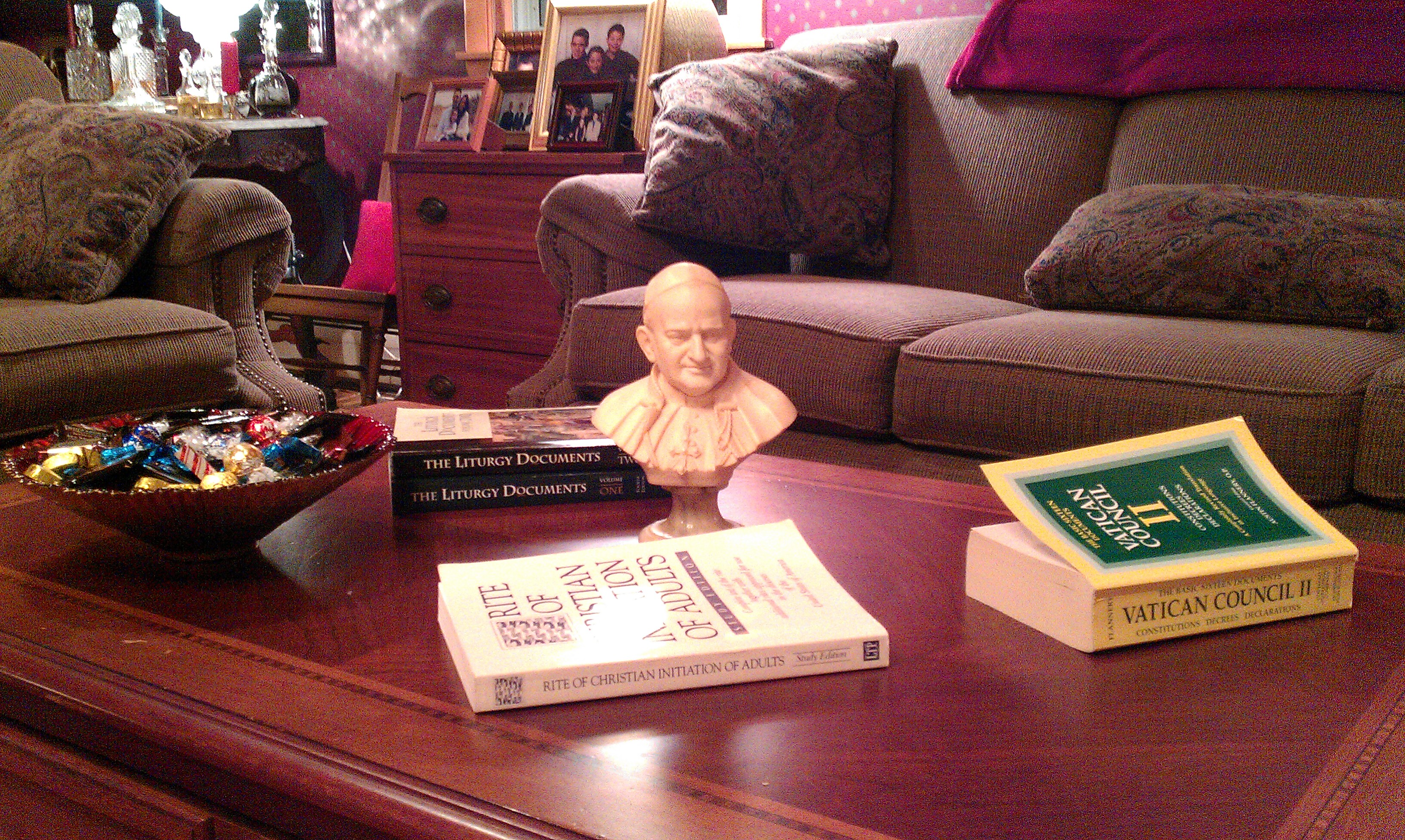
Let me recap the highlights from the tweets sent out from last night's Living Room Dialogue. Followers could live tweet throughout the conversation at hashtag #RoncalliLRD2, a new way to communicate and evangelize the Christian faith. Many thanks to Joanne Mercier for tweeting throughout the event. Follow Joanne on Twitter at Ritual Diva and read her blog, The Rite Stuff and her column in Ministry and Liturgy Magazine. 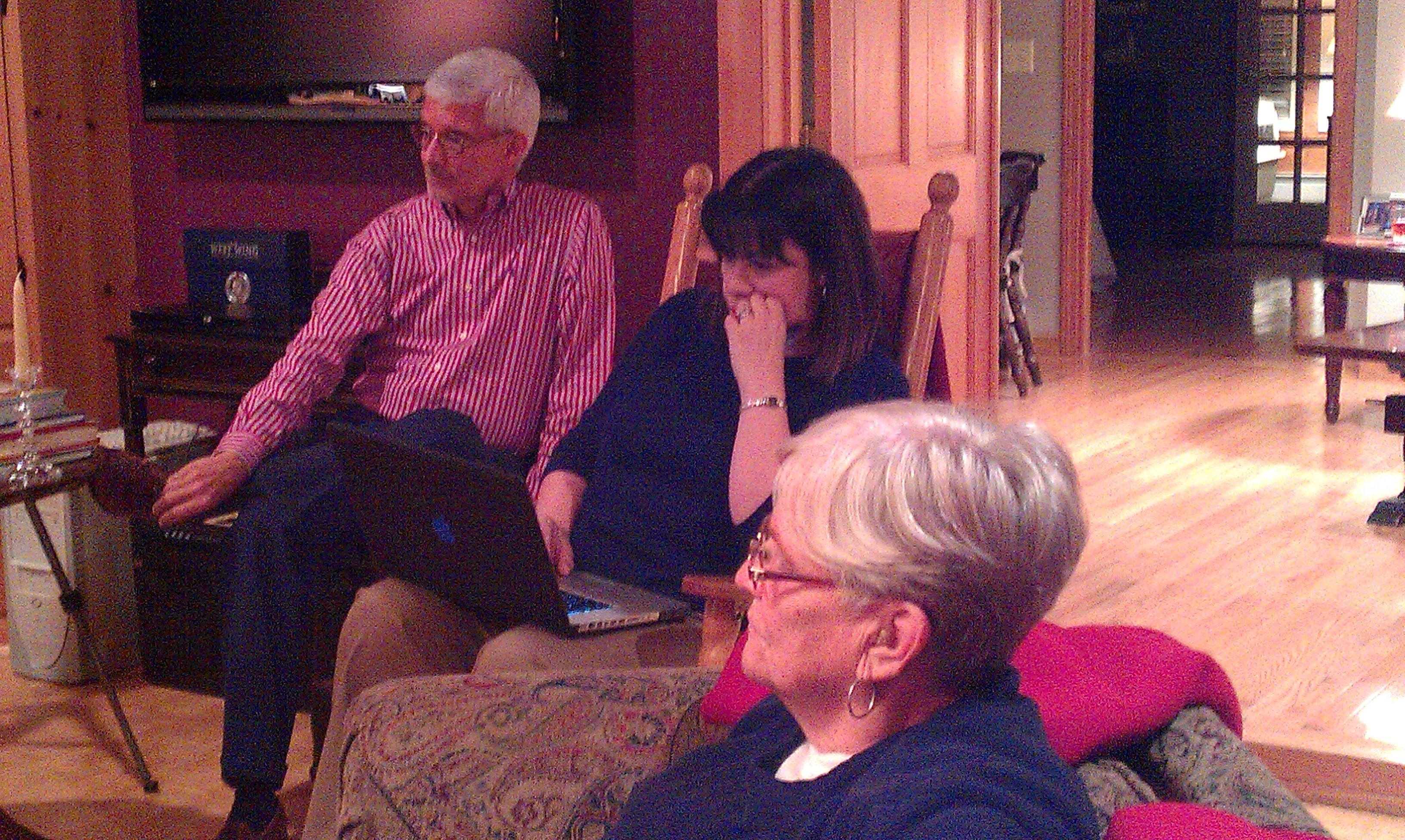
Michael and Kathy Sites led the dialogue on the catechumenate. Kathy Sites coordinated a Beginnings and Beyond in 1999. Then a member of Immaculate Conception in Easton, MA, Kathy and Michael, their pastor Fr. Lou Phillipino and associate pastor Fr. Paul Caron, with liturgical environmentalist Rose Keleher and several other parishioners formed the host staff that assisted the leadership team from the North American Forum for the Catechumenate to lead approximately 100 people through the Rite of Christian Initiation in its full form. The four day retreat was held at Stonehill College. Michael and Kathy have been involved as parish leaders of catechumenate teams since that time. 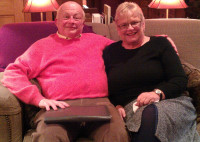
One insight that they brought to the evening gave the participants insight on the adaptability of the Rite because each person comes to the light of faith in a different way. Children often lead their parents into a faith journey. "Never underestimate what children can do for us," Kathy said.She shared one story of how a parent decided that it was time to become fully initiated when his own children were involved in sacramental preparation. Another uninitiated adult made a similar decision after her children told her that she loved Catholics because 'they had a lot of fun' at worship and as a caring community.
Michael pointed out that each person's progress within the process of Christian conversion relies on the flexibility the Rite offers in the way of formation. That requires deep listening on the part of the formation team to inquirers and catechumens. Mutual listening on the part of the leadership team, the inquirers and catechumens and the community deepens the faith of everyone involved. That includes the entire parish, whose principle duty is to evangelize their Christian faith.
One poignant question propelled an interesting part of the dialogue. "Does a parish first build a team and then expect inquirers to come?" 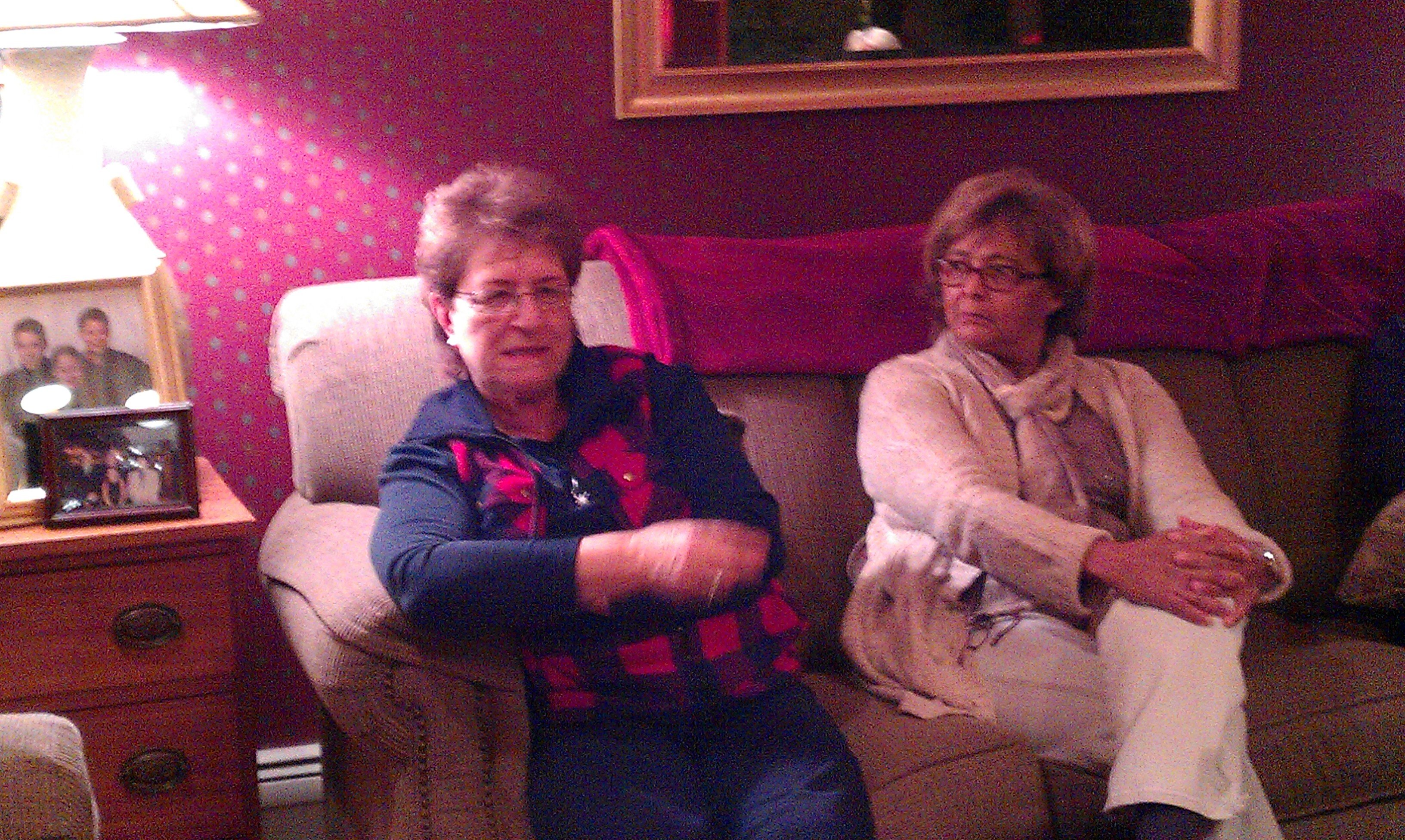 Great question. If you build it, will they come? "It takes someone who lights the fire!" As one participant pointed out, the leadership still begins with the pastor of the parish, whose zeal and energy for faith must light a blaze that fans the flame of passion for Christ.
Great question. If you build it, will they come? "It takes someone who lights the fire!" As one participant pointed out, the leadership still begins with the pastor of the parish, whose zeal and energy for faith must light a blaze that fans the flame of passion for Christ.
Fr. Paul Caron, pastor of St. Anthony/St. Rita with many years of experience as a strong leader of the catechumenate shared that after he attended his first Beginnings and Beyond and met the 'patron saint of Christian Initiation,' Fr. James Dunning in its infancy, he came back to his parish and said, "We're doing this." Fr. Caron initiated catechumenate teams in four parishes since then.
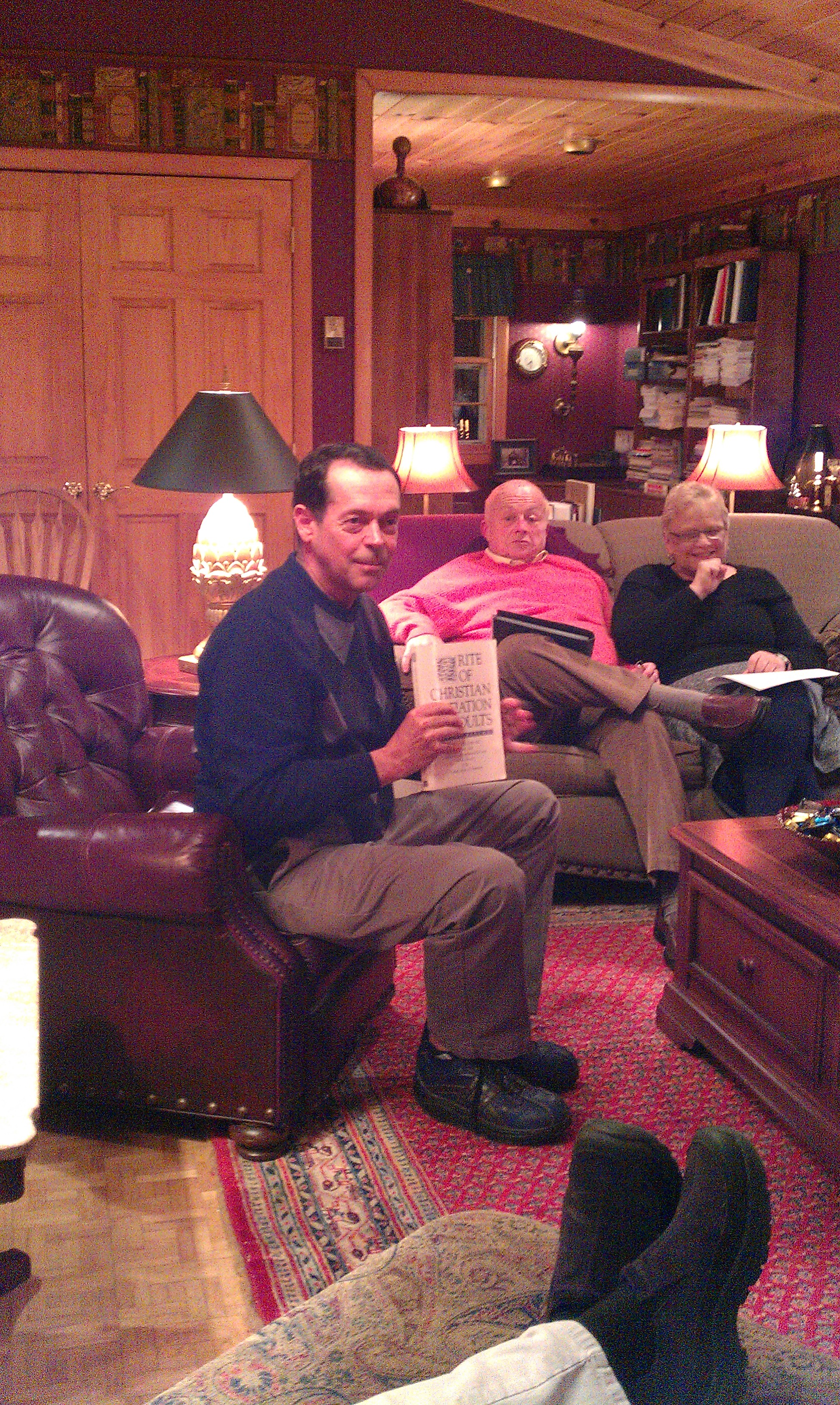 Fr. Caron reached for the Rite of Christian Initiation for Adults and held it up. "This is NOT an option for a parish; it's a MANDATE."
Fr. Caron reached for the Rite of Christian Initiation for Adults and held it up. "This is NOT an option for a parish; it's a MANDATE."
Michael Sites added that "clergy must be willing to collaborate but so many priests are over extended. Laity must step up to help." Another participant agreed. "The details of getting an initiation ministry up and running is not easy and a lot of work. But the outcome is so worthwhile for the parish and inquirers."
"If people have not experienced the rites and been part of that process, telling them about it will not have the same affect. These rites and rituals are powerful and need to experience through the senses. That's when the richness becomes real," one of the participants noted. "It's hard to maintain a team when folks get weary of unfocused. But the process of Christian Initiation is very doable when an entire community participates. The rewards are limitless. We're ALL called to be initiating communities. That's the work of every baptized Christian."
"Once you experience the Rite of Christian Initiation, you know how it can transform people. You can never go back and there is a real grief when the Rite is absent from other parishes you visit," one participant observed.
The conversation began at 7pm around the coffee table and ended around the banquet table over food and reflection. Word, food and reflection. Remind anyone of worship?
Thanks to all who came, shared and sparked the fire to ignite another parish (or two or three?) to consider the Rite of Christian Initiation in their parish.
Need help? Let us know. We're here to assist you!
 Denise Morency Gannon
Denise Morency Gannon